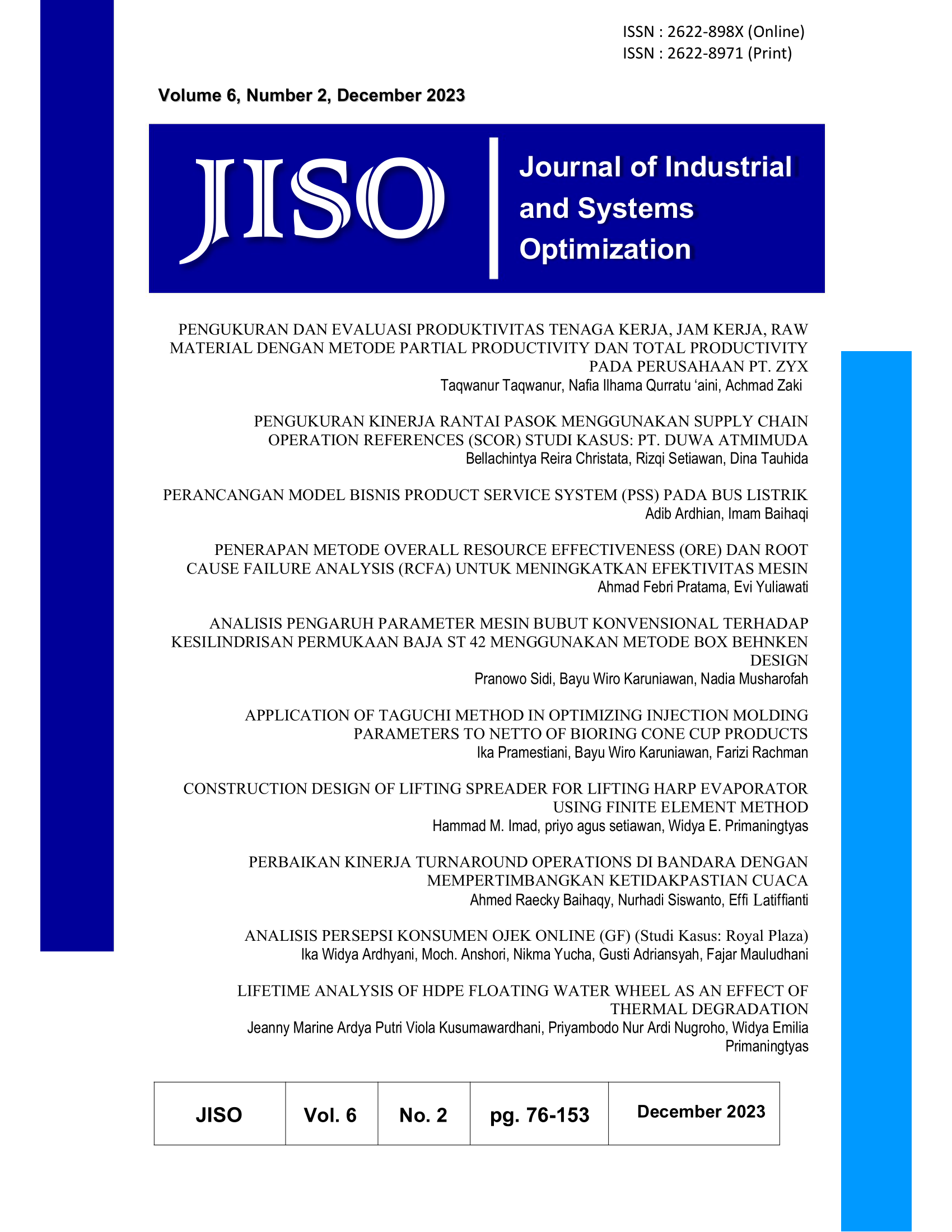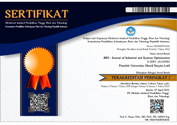LIFETIME ANALYSIS OF HDPE FLOATING WATER WHEEL AS AN EFFECT OF THERMAL DEGRADATION
DOI:
https://doi.org/10.51804/jiso.v6i2.147-153Keywords:
Service Life, Tensile Strength, Polymer, Float, Maintenance.Abstract
The water wheel is an important tool used in cultivating vaname shrimp, which functions as depositing oxygen in cultivation ponds. HDPE is a polymer material used as a waterwheel float. In outdoor working environment of the waterwheel float in the cultivation pond, which exposed to direct sunlight, resulting in an increase in temperature. The influence of heat from the sun certainly affects to the degradation process of the waterwheel float. In this study, HDPE material was given a variety of heat treatments. The variation of heat given was adjusted to the results of observing field conditions for 1 week where the water wheel was used in the aquaculture pond. The variations of heat treatment given were without treatment, lowest, average, highest temperature heat treatment, and cycles. This research aims to determine the effect of heat on reducing tensile strength, the condition of the functional groups contained, and the service life of the material. The result was a 9% reduction in tensile strength in the samples that were given the highest thermal treatment. Degradation due to thermal effects is proven by the decrease in wave peak intensity for each functional group contained in the HDPE material. Calculation of the estimated service life of the HDPE float must be replaced as fast within 5 months.
Kincir air merupakan alat yang penting yang digunakan dalam melakukan budidaya udang vaname, yang berfungsi sebagai alat deposit oksigen pada kolam budidaya. HDPE adalah salah satu material polimer yang digunakan sebagai pelampung kincir air. Lingkungan kerja pelampung kincir air pada kolam budidaya yang terletak di luar ruangan, yang tentunya terpapar matahari langsung, mengakibatkan adanya peningkatan temperatur. Pengaruh panas dari matahari tentunya berpengaruh pada proses degradasi pelampung kincir air. Dalam penelitian ini, material HDPE diberikan variasi perlakuan panas. Variasi panas yang diberikan disesuaikan hasil observasi kondisi lapangan selama 1 minggu di tempat kincir air digunakan pada kolam budidaya. Variasi perlakuan panas yang diberikan yaitu tanpa perlakuan, perlakuan panas temperatur terendah, rata-rata, tertinggi, dan siklus. Penelitian ini memiliki tujuan untuk dapat mengetahui pengaruh panas terhadap penurunan kekuatan tarik, kondisi gugus fungsi yang terkandung, serta umur pakai material. Didapatkan hasil penurunan 9% kekuatan tarik pada sampel yang diberi perlakuan termal tertinggi. Degradasi akibat pengaruh thermal dibuktikan dengan turunnya intensitas puncak gelombang pada tiap-tiap gugus fungsi yang terkandung di dalam material HDPE. Perhitungan perkiraan umur pakai pelampung HDPE paling cepat harus diganti dalam jangka waktu 5 bulan
References
ASTM (American Society for Testing and Material). 2015. Standard Test Method for Tensile Properties of Plastics, ASTM International. United States.
Fitri, A. A. (2022). Studi Pengujian Gugus Fungsi (FTIR) Biopolimer dari Kulit Singkong untuk Meningkatkan Viskositas Air Formasi sebagai Bahan Alternatif dalam Mengatasi Water Coning. Tugas Akhir. Teknik Perminyakan, Universitas Islam Riau, Pekanbaru.
Muharrami, K. L. (2013). Uji Karakterisasi Tarik dan Termal Plastik HDPE dengan Filler Abu Layang dan Silane. Jurnal Rekayasa. Vol.6, No.2, pp. 82-88.
Mulyono, B. A. & Purwanto, H. E. (2021). Umur Simpan (Shelf Life) dan Umur Pakai (Service Life) Selang Termoplastik Elastomer (TPE) dari Perspektif Standarisasi, Produsen, dan Konsumen. Seminar Nasional Teknik Industri Universitas Gadjah Mada. pp. 13-17.
Nazriati, Fajaroh, F., Santosa, A. & Rizqiyah, L. (2019). Efek Radiasi Sinar Matahari dan Sinar Ultra Violet pada Plastik Styrofoam Kemasan Makanan dan Minuman. Jurnal Cis-Trans. Vol.3, No.1, pp. 23-33.
Ni’mah, L. Y., Atmaja, L. & Juwono, H. (2009). Sintesis dan Karakterisasi Film Plastik HDPE Pengemas Herbisida Menggunakan Filler Abu Layang Kelas F. Jurnal. Vol.9, No.3, pp. 348-354.
Plota, A. & Masek, A. (2020). Lifetime Prediction Methods for Degradable Polymeric Materials – A Short Review. Materials, pp. 1-25.
Putri, S. A. (2022). Analisis Pengaruh Variasi Parameter 3D Printing terhadap Kekuatan Tarik, Kekuatan Impak, dan Building Time Menggunakan Metode Taguchi-Grey Relational Analysis. Tugas Akhir. Teknik Desain dan Manufaktur, Jurusan Teknik Permesinan Kapal, Politeknik Perkapalan Negeri Surabaya.
Suwoyo, S.H. & Tampangallo, R.B. (2015). Perkembangan Populasi Bakteri pada Media Budidaya Udang Vaname (Litopenaeus vannamei) dengan Penambahan Sumber Karbon Berbeda. Jurnal. Vol.4, No.1, pp. 365-374.
Suyadi, (2010). Kaji Eksperimen Perbedaan Kekuatan Tarik Sampel Berbahan Plastik HDPE dengan LDPE Daur Ulang. Jurnal. pp. 14-18.
Tjipto, S., B. Edy, S., Tunjung, I. Y., Suparjono, M., Bambang, S.,
Prayitno, Agus, H. I., Budiono, S., Tumpal, P., Futichah, Wagiyo, H. W. (1995). Pengaruh Rasiasi Neutron Cepat terhadap Sifat Fisik dan Mekanik Polimer HDPE, LDPE dan PS. Prosiding Pertemuan dan Presentasi Ilmiah. pp. 104-109.
Downloads
Published
Issue
Section
License
Copyright (c) 2023 JISO : Journal of Industrial and Systems Optimization

This work is licensed under a Creative Commons Attribution-ShareAlike 4.0 International License.
With the receipt of the article by JISO Editorial Board and the decision to be published, the copyright regarding the article will be transferred to JISO. The copyright transfer form can be downloaded here.
JISO has the right to multiply and distribute the article and every author is not allowed to publish the same article that was published in this journal.
JISO is licensed under a Creative Commons Attribution-ShareAlike 4.0 International License.
Under the following terms:
Attribution — You must give appropriate credit, provide a link to the license, and indicate if changes were made. You may do so in any reasonable manner, but not in any way that suggests the licensor endorses you or your use.
ShareAlike — If you remix, transform, or build upon the material, you must distribute your contributions under the same license as the original.














